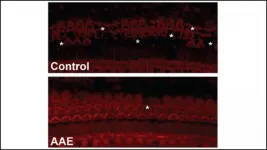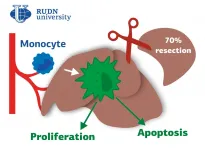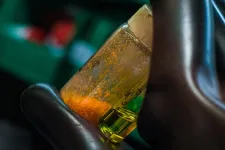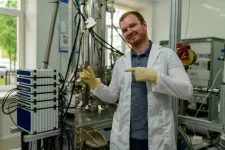(Press-News.org) While the LGBTQ+ community has seen significant advancements in legal rights, political representation and social acceptance over recent years, mental and physical health disparities still exist for queer Americans - and are even worse among younger generations, says a new study from Michigan State University.
In the first-ever population-based national study comparing mental and physical health of lesbian, gay and bisexual (LGB) Americans to their straight counterparts, MSU sociologist Hui Liu and research partner Rin Reczek, professor of sociology from Ohio State University, found that when compared to their straight counterparts, LGB Millennials have worse health disadvantages than their older peers, though disparities persist throughout older generations as well.
"Because younger LGB generations have grown up in a more progressive era, we expected that they may experience lower levels of lifetime discrimination and thus have lower levels of health disadvantage than older LGB generations. However, our results showed the opposite to be true," Liu said.
The study, funded by the National Institute of Health and published in the journal Demography, examined five key indicators of physical and mental health - psychological distress, depression, anxiety, self-rated physical health and activity limitation - of nearly 180,000 study participants across Millennial, Generation X, Baby Boomer and pre-Boomer generational cohorts.
Surprisingly, Liu and Reczek found that health disadvantages for LGB individuals increased among more recent generational cohorts, with LGB Millennials suffering more health disadvantages than LGB Gen-Xers or Baby Boomers. Moreover, bisexual respondents experienced even worse health disparity trends across generations than their gay and lesbian peers.
For example, the study found that gay and lesbian Baby Boomers are 150% more likely to experience both anxiety and depression compared to straight peers; bisexual
Boomers are also about 150% more likely to experience anxiety than their straight peers but over twice as likely to experience depression.
Comparatively, for gay and lesbian Millennials, the likelihood of feeling anxious and depressed is almost 200% and 250% higher than that of their straight peers, respectively, and bisexual Millennials have an almost 300 and 380% increased likelihood than their straight peers.
"Older LGB people have experienced significant interpersonal and institutional discrimination throughout their lives, so they may perceive the current era to be relatively better than the past, and therefore may experience improved well-being as a result of this perception," Liu said.
She also suggests that the findings could be explained by the fact that older LGB people have had more time to develop better coping skills than their younger peers, and that more Millennials identify as LGB than older generations.
Liu is hopeful that this study will demonstrate that advancements in civil rights and social acceptance for the LGBTQ+ community have not yet translated into health equity.
"These health disparities may be a result of more insidious and deeply embedded factors in U.S. society that are not eradicated simply with changes in marriage or discrimination laws," Liu said.
"Instead, more drastic societal changes at both the interpersonal and institutional levels must take place. Public policies and programs should be designed and implemented to eliminate health and other major disadvantages among LGBTQ+ Americans."
INFORMATION:
Note for media: please include the following link in media coverage: https://read.dukeupress.edu/demography/article/doi/10.1215/00703370-9357508/173829/Birth-Cohort-Trends-in-Health-Disparities-by
All coronaviruses produce four primary structural proteins and multiple nonstructural proteins. However, the majority of antibody-based SARS-CoV-2 research has focused on the spike and nucleocapsid proteins. A study published in PLOS Biology by Anna Heffron, Irene Ong and colleagues at the University of Wisconsin-Madison, USA, suggests that immune responses may develop against other proteins produced by the SARS-CoV-2 virus.
The efficacy of spike protein-based vaccines is variable and not everyone infected with SARS-CoV-2 produces detectable antibodies against the spike or ...
In a new study published today in the American Journal of Human Genetics, researchers announced the development of a new method to increase the utility and equity of large genetic databases. The research was conducted by Audrey Hendricks, an associate professor of statistics at the University of Colorado Denver (CU Denver).
Summix, the new method developed by Hendricks and her team of CU Denver undergraduate and graduate students, estimates the genetic ancestry in databases and adjusts the information to match the ancestry of a person or sample of people. This method leads large genetic databases to become more useful for people of various ancestries such as African American or Latinx, as they are underrepresented in genetic ...
Every day, our bodies face a bombardment of UV rays, ozone, cigarette smoke, industrial chemicals and other hazards.
This exposure can lead to free-radical production in our bodies, which damages our DNA and tissues. A new study from West Virginia University researcher Eric E. Kelley--in collaboration with the University of Minnesota--suggests that unrepaired DNA damage can increase the speed of aging.
The study appears in the journal Nature.
Kelley and his team created genetically-modified mice with a crucial DNA-repair protein missing from their hematopoietic stem cells, immature immune cells that develop into white blood cells. Without this ...
Broadband sounds embedded with short pauses can maintain temporal sound processing in a mouse model of hearing loss, according to new research published in eNeuro.
Hearing loss treatments supplement auditory system function but don't repair it. However a new intervention -- playing broadband sounds during the onset of hearing loss -- may be able to prevent the damage from ever occurring. Augmented auditory environments have been able to preserve auditory processing of a wide range of sound frequencies in mice models. In a new study, Dziorny et al. modified the traditional paradigm and preserved the processing of time-related, or temporal, sound features which are vital for understanding speech.
The research team exposed mice with congenital hearing loss to ...
DURHAM, N.C. - In the fight against viruses, antibodies have the potential to either block infection or enable infection and make the disease worse, leading to concern about their use as a therapy for COVID-19.
In a study published in the journal END ...
RUDN University doctors found out what role macrophages play in the recovery of the liver after the removal of its significant part. The results are published in the journal Biomedicine & Pharmacotherapy.
The liver in mammals is the most regenerative internal organ. It can restore the original size from as little as 25% of the preserved tissue. An important role in this process is played by macrophages. These are the cells that can engulf and digest particles. It is known, for example, that if the liver is affected by foreign substances, including drugs, macrophages migrate to the liver, absorb harmful microorganisms and dead cells, cause inflammation and thus contribute to the restoration of the organ. However, it is still unknown unambiguously how macrophages affect the ...
Nearly a third of Americans who arranged for paid care for an older person or someone with dementia employed workers who were not hired through a regulated agency, according to a new RAND Corporation study.
Individuals who hired gray market caregivers were less likely to be employed and more likely to also use unpaid care for their family members. In addition, people who lived in rural areas had an almost five-times higher odds of arranging dementia care through gray markets as compared to those who lived in urban areas.
The study is the first national survey to probe the use of gray market care for older adults and people with dementia. The findings ...
HOUSTON - (June 21, 2021) - Rice University engineers have created microscopic seeds for growing remarkably uniform 2D perovskite crystals that are both stable and highly efficient at harvesting electricity from sunlight.
Halide perovskites are organic materials made from abundant, inexpensive ingredients, and Rice's seeded growth method addresses both performance and production issues that have held back halide perovskite photovoltaic technology.
In a study published online in Advanced Materials, chemical engineers from Rice's Brown School of Engineering describe how to make the seeds and use them to grow homogenous thin films, highly sought ...
A team of scientists from NUST MISIS and MIPT have developed and tested a new platform for realization of the ultra-strong photon-to-magnon coupling. The proposed system is on-chip and is based on thin-film hetero-structures with superconducting, ferromagnetic and insulating layers. This discovery solves a problem that has been on the agenda of research teams from different countries for the last 10 years, and opens new opportunities in implementing quantum technologies. The study was published in the highly ranked journal Science Advances.
The last decade has seen significant progress ...
AMHERST, Mass. - Millions of Americans will visit New England's beaches this summer to cool off, play in the waves and soak up the sun. Until now, the factors governing which beaches slope gradually to the sea and which ones end abruptly in a steep drop-off have been largely unknown. However, new research from the University of Massachusetts Amherst reveals, with unprecedented detail, how the grain size of beach sand relates to the slope of the beach itself. These new findings are critical to understanding how New England's beaches will respond to both rising sea levels and increased storm activity.
Many of New England's beaches are made up of a mixture of sand and small stones. Or, to be more precise, the grain sizes on these beaches are "bi-modal" ...






